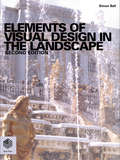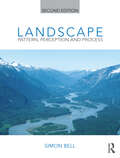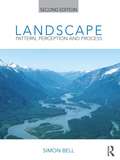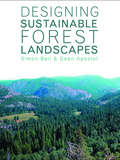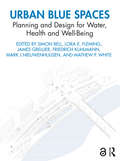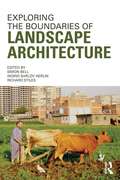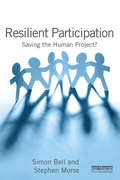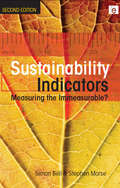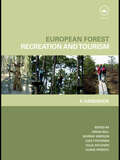- Table View
- List View
Elements of Visual Design in the Landscape
by Simon BellPublic concern about the landscape, in particular its appearance, is increasing all the time. For those charged with managing, developing or conserving a wide range of landscapes it is a major task to take visual aspects into account. Elements of Visual Design in the Landsacpe presents a vocabulary of visual design, structured in a logical and easy to follow sequence. It is profusely illustrated using both abstract and real examples taken from a wide range of international locations together with cross referencing between related principles and case studies demonstrating how the principles can be applied in practice. The visual aspects of design have often been treated as 'cosmetic' and therefore not meriting attention or purely subjective and therefore open to personal preference. Few attempts have been made to explain how we see the landscape in any rational and structured way, and to demonstrate how visually creative design and management can be undertaken. This book aims to fill that gap.
Elements of Visual Design in the Landscape
by Simon BellWhat makes a visually appealing landscape? How can the design and use of a landscape be harmonized? In this significantly revised and updated third edition of Simon Bell's seminal text, he further explores the answers to these questions by interrogating a range of design principles, applications and ideas. Written for students, instructors and professionals, the book unveils a visual design vocabulary for anyone involved with landscape aesthetics including landscape architects, architects, planners, urban designers, landscape managers, foresters, geographers and ecologists. Structured around key design terms, which are explained and illustrated using an extensive range of examples from around the world, including North America, Europe and Asia, this book enables you to describe, debate and design the visual landscape. It starts with basic elements, before moving onto variable design components, and then the ways these elements are organized into compositions, in order to demonstrate how landscapes are created and how meanings and patterns are perceived within them. This new full colour edition contains over 240 images; an updated introduction; examples from China, Vietnam and central Asia; a chapter on how to read and understand visual design elements in the landscape; a teaching model for instructors; and expanded appendix materials including a glossary, references and further reading.
Elements of Visual Design in the Landscape
by Simon BellWhat makes a visually appealing landscape? How can the design and use of a landscape be harmonized? In this significantly revised and updated third edition of Simon Bell's seminal text, he further explores the answers to these questions by interrogating a range of design principles, applications and ideas. Written for students, instructors and professionals, the book unveils a visual design vocabulary for anyone involved with landscape aesthetics including landscape architects, architects, planners, urban designers, landscape managers, foresters, geographers and ecologists. Structured around key design terms, which are explained and illustrated using an extensive range of examples from around the world, including North America, Europe and Asia, this book enables you to describe, debate and design the visual landscape. It starts with basic elements, before moving onto variable design components, and then the ways these elements are organized into compositions, in order to demonstrate how landscapes are created and how meanings and patterns are perceived within them. This new full colour edition contains over 240 images; an updated introduction; examples from China, Vietnam and central Asia; a chapter on how to read and understand visual design elements in the landscape; a teaching model for instructors; and expanded appendix materials including a glossary, references and further reading.
Landscape: Pattern, Perception and Process
by Simon BellLandscapes develop and evolve through an interacting series of processes – climatic, geological, ecological and cultural – over varying periods of time. These processes shape the structure and character of the landscapes which we experience. Over time, distinctive patterns emerge – ranging in scale from the distribution of small plants to the sculptured sides of a huge canyon. Our perception of these patterns goes beyond just their visual appreciation – beautiful though they may be – into a richer understanding of how we experience our environment. By understanding this complex pattern–process interaction we can obtain a deeper awareness of landscape and our place in it – as inhabitants and as shapers. The book explores the nature of patterns and ways of classifying them before studying the nature of perception (primarily visual but including other senses), then proceeds to relate this perception to aesthetics and from there to the design process. From this point the main driving processes in landscape are introduced alongside the resulting patterns, these being climatic, landform, ecosystem and cultural aspects. It is this integrative approach of looking at landscape as a kind of self-organising system, overlaid by conscious human planning activities and the unity of pattern and process, which makes this book unique. Landscape draws from a wide range of neighbouring disciplines, of which the landscape planner or designer needs to be aware, but which are often taught as distinct elements. Bell binds these fundamentals together, which enables the landscape to be ‘read’, and this reading to be used as the basis for planning and design. This second edition updates and refreshes the original material with added sections and new photos, particularly making use of the developments in satellite photography. Featuring full colour throughout, this textbook is ideal for anyone studying landscape architecture or any of the disciplines which intersect with the landscape, and which affect it.
Landscape: Pattern, Perception and Process
by Simon BellLandscapes develop and evolve through an interacting series of processes – climatic, geological, ecological and cultural – over varying periods of time. These processes shape the structure and character of the landscapes which we experience. Over time, distinctive patterns emerge – ranging in scale from the distribution of small plants to the sculptured sides of a huge canyon. Our perception of these patterns goes beyond just their visual appreciation – beautiful though they may be – into a richer understanding of how we experience our environment. By understanding this complex pattern–process interaction we can obtain a deeper awareness of landscape and our place in it – as inhabitants and as shapers. The book explores the nature of patterns and ways of classifying them before studying the nature of perception (primarily visual but including other senses), then proceeds to relate this perception to aesthetics and from there to the design process. From this point the main driving processes in landscape are introduced alongside the resulting patterns, these being climatic, landform, ecosystem and cultural aspects. It is this integrative approach of looking at landscape as a kind of self-organising system, overlaid by conscious human planning activities and the unity of pattern and process, which makes this book unique. Landscape draws from a wide range of neighbouring disciplines, of which the landscape planner or designer needs to be aware, but which are often taught as distinct elements. Bell binds these fundamentals together, which enables the landscape to be ‘read’, and this reading to be used as the basis for planning and design. This second edition updates and refreshes the original material with added sections and new photos, particularly making use of the developments in satellite photography. Featuring full colour throughout, this textbook is ideal for anyone studying landscape architecture or any of the disciplines which intersect with the landscape, and which affect it.
Learning with Information Systems: Learning Cycles in Information Systems Development (Routledge Research in Information Systems)
by Simon BellIn Learning with Information Systems the author takes the developing world as the context and through a series of case studies develops a commonly used systems analysis methodology. He demonstrates how this methodology can evolve and adapt as new ideas become prominent. Issues of sustainability of information systems, participation in systems design and user ownership of systems are all examined. This book does not attempt to be prescriptive for all contexts nor does it focus on any particular technology. It addresses the essential questions and promises practical approaches which will help in the avoidance of the worst forms of disaster associated with the planning of information systems for developing countries.
Learning with Information Systems: Learning Cycles in Information Systems Development (Routledge Research in Information Systems)
by Simon BellIn Learning with Information Systems the author takes the developing world as the context and through a series of case studies develops a commonly used systems analysis methodology. He demonstrates how this methodology can evolve and adapt as new ideas become prominent. Issues of sustainability of information systems, participation in systems design and user ownership of systems are all examined. This book does not attempt to be prescriptive for all contexts nor does it focus on any particular technology. It addresses the essential questions and promises practical approaches which will help in the avoidance of the worst forms of disaster associated with the planning of information systems for developing countries.
Designing Sustainable Forest Landscapes
by Simon Bell Dean ApostolDesigning Sustainable Forest Landscapes is a definitive guide to the design and management of forest landscapes, covering the theory and principles of forest design as well as providing practical guidance on methods and tools. Including a variety of international case studies the book focuses on ecosystem regeneration, the management of natural forests and the management of plantation forests. Using visualisation techniques, design processes and evaluation techniques it looks at promoting landscapes which are designed to optimise the balance between human intervention and natural evolution. A comprehensive, practical and accessible book, Designing Sustainable Forest Landscapes is essential reading for all those involved in forestry and landscape professions.
Designing Sustainable Forest Landscapes
by Simon Bell Dean ApostolDesigning Sustainable Forest Landscapes is a definitive guide to the design and management of forest landscapes, covering the theory and principles of forest design as well as providing practical guidance on methods and tools. Including a variety of international case studies the book focuses on ecosystem regeneration, the management of natural forests and the management of plantation forests. Using visualisation techniques, design processes and evaluation techniques it looks at promoting landscapes which are designed to optimise the balance between human intervention and natural evolution. A comprehensive, practical and accessible book, Designing Sustainable Forest Landscapes is essential reading for all those involved in forestry and landscape professions.
Urban Blue Spaces: Planning and Design for Water, Health and Well-Being
by Simon Bell Lora E. Fleming James Grellier Friedrich Kuhlmann Mark J. Nieuwenhuijsen Mathew P. WhiteThis book presents an evidence-based approach to landscape planning and design for urban blue spaces that maximises the benefits to human health and well-being while minimising the risks. Based on applied research and evidence from primary and secondary data sources stemming from the EU-funded BlueHealth project, the book presents nature-based solutions to promote sustainable and resilient cities. Numerous cities around the world are located alongside bodies of water in the form of coastlines, lakes, rivers and canals, but the relationship between city inhabitants and these water sources has often been ambivalent. In many cities, water has been polluted, engineered or ignored completely. But, due to an increasing awareness of the strong connections between city, people, nature and water and health, this paradigm is shifting. The international editorial team, consisting of researchers and professionals across several disciplines, leads the reader through theoretical aspects, evidence, illustrated case studies, risk assessment and a series of validated tools to aid planning and design before finishing with overarching planning and design principles for a range of blue-space types. Over 200 full-colour illustrations accompany the case-study examples from geographic locations all over the world, including Portugal, the United Kingdom, China, Canada, the US, South Korea, Singapore, Norway and Estonia. With green and blue infrastructure now at the forefront of current policies and trends to promote healthy, sustainable cities, Urban Blue Spaces is a must-have for professionals and students in landscape planning, urban design and environmental design. Open Access for the book was funded by the European Union's Horizon 2020 research and innovation programme under grant agreement No 666773
Exploring the Boundaries of Landscape Architecture
by Simon Bell Ingrid Sarlov Herlin Richard StilesWhat have cultural anthropologists, historical geographers, landscape ecologists and environmental artists got in common? Along with eight other disciplines, from domains as diverse as planning and design, the arts and humanities as well as the social and natural sciences, they are all fields of importance to the theory and practice of landscape architecture. In the context of the EU funded LE:NOTRE Project, carried out under the auspices of ECLAS, the European Council of Landscape Architecture Schools, international experts from a wide range of related fields were asked to reflect, each from their own perspective, on the interface between their discipline and landscape architecture. The resulting insights presented in this book represent an important contribution to the development the discipline of landscape architecture, as well as suggesting new ways in which future collaboration can help to create a greater interdisciplinary richness at a time when the awareness of the importance of the landscape is growing across a wide range of disciplines. Exploring the Boundaries of Landscape Architecture is the first systematic attempt to explore the territory at the boundaries of landscape architecture. It addresses academics, professionals and students, not just from landscape architecture but also from its neighbouring discipline, all of whom will benefit from a better understanding their areas of shared interest and the chance to develop a common language with which to converse.
Exploring the Boundaries of Landscape Architecture
by Simon Bell Ingrid Sarlöv Herlin Richard StilesWhat have cultural anthropologists, historical geographers, landscape ecologists and environmental artists got in common? Along with eight other disciplines, from domains as diverse as planning and design, the arts and humanities as well as the social and natural sciences, they are all fields of importance to the theory and practice of landscape architecture. In the context of the EU funded LE:NOTRE Project, carried out under the auspices of ECLAS, the European Council of Landscape Architecture Schools, international experts from a wide range of related fields were asked to reflect, each from their own perspective, on the interface between their discipline and landscape architecture. The resulting insights presented in this book represent an important contribution to the development the discipline of landscape architecture, as well as suggesting new ways in which future collaboration can help to create a greater interdisciplinary richness at a time when the awareness of the importance of the landscape is growing across a wide range of disciplines. Exploring the Boundaries of Landscape Architecture is the first systematic attempt to explore the territory at the boundaries of landscape architecture. It addresses academics, professionals and students, not just from landscape architecture but also from its neighbouring discipline, all of whom will benefit from a better understanding their areas of shared interest and the chance to develop a common language with which to converse.
Urban Blue Spaces: Planning and Design for Water, Health and Well-Being
by Simon Bell Friedrich Kuhlmann Mathew P. White Mark J. Nieuwenhuijsen James Grellier Lora E. FlemingThis book presents an evidence-based approach to landscape planning and design for urban blue spaces that maximises the benefits to human health and well-being while minimising the risks. Based on applied research and evidence from primary and secondary data sources stemming from the EU-funded BlueHealth project, the book presents nature-based solutions to promote sustainable and resilient cities. Numerous cities around the world are located alongside bodies of water in the form of coastlines, lakes, rivers and canals, but the relationship between city inhabitants and these water sources has often been ambivalent. In many cities, water has been polluted, engineered or ignored completely. But, due to an increasing awareness of the strong connections between city, people, nature and water and health, this paradigm is shifting. The international editorial team, consisting of researchers and professionals across several disciplines, leads the reader through theoretical aspects, evidence, illustrated case studies, risk assessment and a series of validated tools to aid planning and design before finishing with overarching planning and design principles for a range of blue-space types. Over 200 full-colour illustrations accompany the case-study examples from geographic locations all over the world, including Portugal, the United Kingdom, China, Canada, the US, South Korea, Singapore, Norway and Estonia. With green and blue infrastructure now at the forefront of current policies and trends to promote healthy, sustainable cities, Urban Blue Spaces is a must-have for professionals and students in landscape planning, urban design and environmental design. Open Access for the book was funded by the European Union's Horizon 2020 research and innovation programme under grant agreement No 666773
Measuring Sustainability: Learning From Doing
by Simon Bell Stephen Morse' Measuring the sustainability of development is crucial to achieving it, and is one of the most actively studied issues in the area. To date, most studies of measurements or indicators have been largely theoretical. However, this book, a follow-on to Bell and Morse's highly influential Sustainability Indicators (1999), presents valuable practical advice on how to develop measurements that will work in real-life development contexts. It describes and analyses how to derive, validate and apply indicators in the course of an actual development project - in this case the Mediterranean Action Plan in Malta. The authors explain the trade-offs and constraints involved and how it is possible to combine the open-ended and flexible perspectives of sustainability with the more linear processes and fixed targets of specific projects through the use of pragmatic and reflective methodologies.
Measuring Sustainability: Learning From Doing
by Simon Bell Stephen Morse' Measuring the sustainability of development is crucial to achieving it, and is one of the most actively studied issues in the area. To date, most studies of measurements or indicators have been largely theoretical. However, this book, a follow-on to Bell and Morse's highly influential Sustainability Indicators (1999), presents valuable practical advice on how to develop measurements that will work in real-life development contexts. It describes and analyses how to derive, validate and apply indicators in the course of an actual development project - in this case the Mediterranean Action Plan in Malta. The authors explain the trade-offs and constraints involved and how it is possible to combine the open-ended and flexible perspectives of sustainability with the more linear processes and fixed targets of specific projects through the use of pragmatic and reflective methodologies.
Resilient Participation: Saving the Human Project?
by Simon Bell Stephen MorseStakeholder or public participation has become something of a modern mantra employed in all sorts of contexts to give people a voice. There are many variants on this 'participation' but traditionally they all share a desire to maximise involvement and provide desired 'outputs' of a required quality as quickly and as cheaply as possible. Difference tends to be reduced and compromise encouraged as the outputs or even just the appearance of participation are emphasised. This book explores the large and diverse range of participatory methods currently in use, examines the problems and gaps in these methods and sets out an innovative new methodology which overcomes these shortcomings. Uniquely, this method builds from the assumption that it is not just the outputs that matter in participation - it is also the journey. 'Triple Task' is designed to help groups explore their current situation and develop a path by which they can improve their functioning and ultimately make a positive contribution to the lives of others. The book includes in-depth case studies of Triple Task in action across a range of contexts and countries, with particular focus on an EU project concerning indicators in policy-making. This new approach can be used in any context and with any sort of group to help them produce more informative 'outputs' in which a deep reflection of how the group works is allied to an analysis of how problems can be solved.
Resilient Participation: Saving the Human Project?
by Simon Bell Stephen MorseStakeholder or public participation has become something of a modern mantra employed in all sorts of contexts to give people a voice. There are many variants on this 'participation' but traditionally they all share a desire to maximise involvement and provide desired 'outputs' of a required quality as quickly and as cheaply as possible. Difference tends to be reduced and compromise encouraged as the outputs or even just the appearance of participation are emphasised. This book explores the large and diverse range of participatory methods currently in use, examines the problems and gaps in these methods and sets out an innovative new methodology which overcomes these shortcomings. Uniquely, this method builds from the assumption that it is not just the outputs that matter in participation - it is also the journey. 'Triple Task' is designed to help groups explore their current situation and develop a path by which they can improve their functioning and ultimately make a positive contribution to the lives of others. The book includes in-depth case studies of Triple Task in action across a range of contexts and countries, with particular focus on an EU project concerning indicators in policy-making. This new approach can be used in any context and with any sort of group to help them produce more informative 'outputs' in which a deep reflection of how the group works is allied to an analysis of how problems can be solved.
Routledge Handbook of Sustainability Indicators (Routledge International Handbooks)
by Simon Bell Stephen MorseThis handbook provides researchers and students with an overview of the field of sustainability indicators (SIs) as applied in the interdisciplinary field of sustainable development. The editors have sought to include views from the center ground of SI development but also divergent ideas which represent some of the diverse, challenging and even edgy observations which are prominent in the wider field of SI thinking. The contributions in this handbook: • clearly set out the theoretical background and history of SIs, their origins, roots and initial goals • expand on the disciplines and modalities employed to develop SIs of various kinds • assess the various ways in which SI data are gathered and the availability (over space and time) and quality issues that surround them • explore the multiplex world of SIs as expressed in agencies around the world, via examples of SI practice and the lessons that have emerged from them • critically review the progress that SIs have made over the last 30 years • express the divergence of views which are held about the value of SIs, including differing theories on their efficacy, efficiency and ethics • explore the frontier of contemporary SI thinking, reviewing ante/post and systemic alternatives This multidisciplinary and international handbook will be of great interest to researchers, students and practitioners working in sustainability research and practice.
Routledge Handbook of Sustainability Indicators (Routledge International Handbooks)
by Simon Bell Stephen MorseThis handbook provides researchers and students with an overview of the field of sustainability indicators (SIs) as applied in the interdisciplinary field of sustainable development. The editors have sought to include views from the center ground of SI development but also divergent ideas which represent some of the diverse, challenging and even edgy observations which are prominent in the wider field of SI thinking. The contributions in this handbook: • clearly set out the theoretical background and history of SIs, their origins, roots and initial goals • expand on the disciplines and modalities employed to develop SIs of various kinds • assess the various ways in which SI data are gathered and the availability (over space and time) and quality issues that surround them • explore the multiplex world of SIs as expressed in agencies around the world, via examples of SI practice and the lessons that have emerged from them • critically review the progress that SIs have made over the last 30 years • express the divergence of views which are held about the value of SIs, including differing theories on their efficacy, efficiency and ethics • explore the frontier of contemporary SI thinking, reviewing ante/post and systemic alternatives This multidisciplinary and international handbook will be of great interest to researchers, students and practitioners working in sustainability research and practice.
Sustainability Indicators: Measuring the Immeasurable?
by Simon Bell Stephen MorsePraise for the first edition: 'This book should be of interest to anyone interested in sustainable development, and especially sustainability indicators. Bell and Morse easily succeed in exposing the fundamental paradoxes of these concepts and, more importantly, they offer us a way forward. Readers ... will find their practical recommendations for those attempting to do sustainability analysis in the field most welcome, which is also the book's greatest strength.' Local Environment: The International Journal of Justice and Sustainability 'This book makes a valuable contribution to the theory and practice of using indicators for sustainability. It introduces systems ideas and a range of tools and techniques that have the potential to broaden and deepen our understanding of a whole range of complex situations. Well worth a closer look.' Christine Blackmore, Open University 'This is a book that explores new ways of thinking about how to measure sustainability... It offers stimulating food for thought for environmental educators and researchers.' Environmental Education Research 'This book tells me, as an SI 'practitioner', where I have been and why, and more importantly how I should be thinking in order to effectively present to and empower the local community in the years ahead.' David Ellis, Principal Pollution Monitoring Officer, Norwich City Council 'A practical guide to the development of sustainability indicators which offers a systemic and participative way to use them at local scale. Our preliminary results are highly positive and the approach is applicable in many contexts.' Elisabeth Coudert, Programme Officer Prospective and Regional Development, Blue Plan The groundbreaking first edition of Sustainability Indicators reviewed the development and value of sustainability indicators and discussed the advantage of taking a holistic and qualitative approach rather than focusing on strictly quantitative measures. In the new edition the authors bring the literature up to date and show that the basic requirement for a systemic approach is now well grounded in the evidence. They examine the origins and development of Systemic Sustainability Analysis (SSA) as a theoretical approach to sustainability which has been developed in practice in a number of countries on an array of projects since the first edition. They look at how SSA has evolved into the practical approaches of Systemic Prospective Sustainability Analysis (SPSA) and IMAGINE, and, in particular, how a wide range of participatory methodologies have been adopted over the years. They also provide an assessment of the strengths and weaknesses of projects that undertake work in the general field of sustainable development.
Sustainability Indicators: Measuring the Immeasurable?
by Simon Bell Stephen MorsePraise for the first edition: 'This book should be of interest to anyone interested in sustainable development, and especially sustainability indicators. Bell and Morse easily succeed in exposing the fundamental paradoxes of these concepts and, more importantly, they offer us a way forward. Readers ... will find their practical recommendations for those attempting to do sustainability analysis in the field most welcome, which is also the book's greatest strength.' Local Environment: The International Journal of Justice and Sustainability 'This book makes a valuable contribution to the theory and practice of using indicators for sustainability. It introduces systems ideas and a range of tools and techniques that have the potential to broaden and deepen our understanding of a whole range of complex situations. Well worth a closer look.' Christine Blackmore, Open University 'This is a book that explores new ways of thinking about how to measure sustainability... It offers stimulating food for thought for environmental educators and researchers.' Environmental Education Research 'This book tells me, as an SI 'practitioner', where I have been and why, and more importantly how I should be thinking in order to effectively present to and empower the local community in the years ahead.' David Ellis, Principal Pollution Monitoring Officer, Norwich City Council 'A practical guide to the development of sustainability indicators which offers a systemic and participative way to use them at local scale. Our preliminary results are highly positive and the approach is applicable in many contexts.' Elisabeth Coudert, Programme Officer Prospective and Regional Development, Blue Plan The groundbreaking first edition of Sustainability Indicators reviewed the development and value of sustainability indicators and discussed the advantage of taking a holistic and qualitative approach rather than focusing on strictly quantitative measures. In the new edition the authors bring the literature up to date and show that the basic requirement for a systemic approach is now well grounded in the evidence. They examine the origins and development of Systemic Sustainability Analysis (SSA) as a theoretical approach to sustainability which has been developed in practice in a number of countries on an array of projects since the first edition. They look at how SSA has evolved into the practical approaches of Systemic Prospective Sustainability Analysis (SPSA) and IMAGINE, and, in particular, how a wide range of participatory methodologies have been adopted over the years. They also provide an assessment of the strengths and weaknesses of projects that undertake work in the general field of sustainable development.
European Forest Recreation and Tourism: A Handbook
by Simon Bell Murray Simpson Liisa Tyrväinen Tuija Sievänen Ulrike PröbstlIn an increasingly urbanized world more and more people are turning to our forests and woodland for recreation and tourism. Planning and providing for this growing demand poses challenges that need to be addressed by managers and designers alike. Based on a study of forest recreation from across Europe, the editors bring together the expertise of more than eighty leading professionals and academics to provide a clear and concise guide to best practice. Case studies and careful research give a detailed insight into the issues that forest recreation raises, from strategic planning to integration into the existing rural economy. Essential reading for tourism planners, landscape designers and countryside managers delivering forest recreation and tourism.
European Forest Recreation and Tourism: A Handbook
by Simon Bell Murray Simpson Lisa Tyrväinen Tuija Sievänen Ulrike PröbstlIn an increasingly urbanized world more and more people are turning to our forests and woodland for recreation and tourism. Planning and providing for this growing demand poses challenges that need to be addressed by managers and designers alike. Based on a study of forest recreation from across Europe, the editors bring together the expertise of more than eighty leading professionals and academics to provide a clear and concise guide to best practice. Case studies and careful research give a detailed insight into the issues that forest recreation raises, from strategic planning to integration into the existing rural economy. Essential reading for tourism planners, landscape designers and countryside managers delivering forest recreation and tourism.
Art Therapy with Neurological Conditions
by Simon Bell Mark Wheeler Christopher Day Jenny Wood Carole Connelly Andrea Gregg Melody Golebiowski Debbie Michaels Marion Green Iris Von Hyde Judith Ducker Anna Knight Elizabeth Ashby Quentin BrucklandBy creating a therapeutic outlet for self-expression and processing trauma, art therapy can play a powerful role in assisting people with a brain injury or neurological condition to adjust to living with altered abilities and ways of thinking. Bringing together a wealth of expertise from specialists working with a range of conditions including epilepsy, dementia, acquired brain injury, motor neurone disease and multiple sclerosis, this book describes both the effects of the conditions and the ways in which art therapy has helped in the rehabilitation process. The book includes work with groups and individuals and with a wide range of settings and age groups, from children to older adults, and discusses the implications of research from neuroscience and neuropsychology.This will be essential reading for art therapists and students working with neurological conditions. Other professionals working with people with neurological conditions such as psychotherapists and counsellors, doctors, nurses and complementary therapists will also find it of interest.
How to Set Up Information Systems: A Non-specialist's Guide to the Multiview Approach
by Simon Bell Trevor Wood-HarperThis introductory user's guide to systems analysis and systems design focuses on building sustainable information systems to meet tomorrow's needs. It shows how practitioners can apply multiple participatory perspectives in development, so as to avoid future problems. As a practical guide, it is presented to be readily comprehensible and is organized to enable users to concentrate on their goals efficiently, and with minimum theoretical elaboration. The chapters follow the sequence involved in planning an information system, explaining key words, the time involved in each step, ending with a tutorial or exercises.
